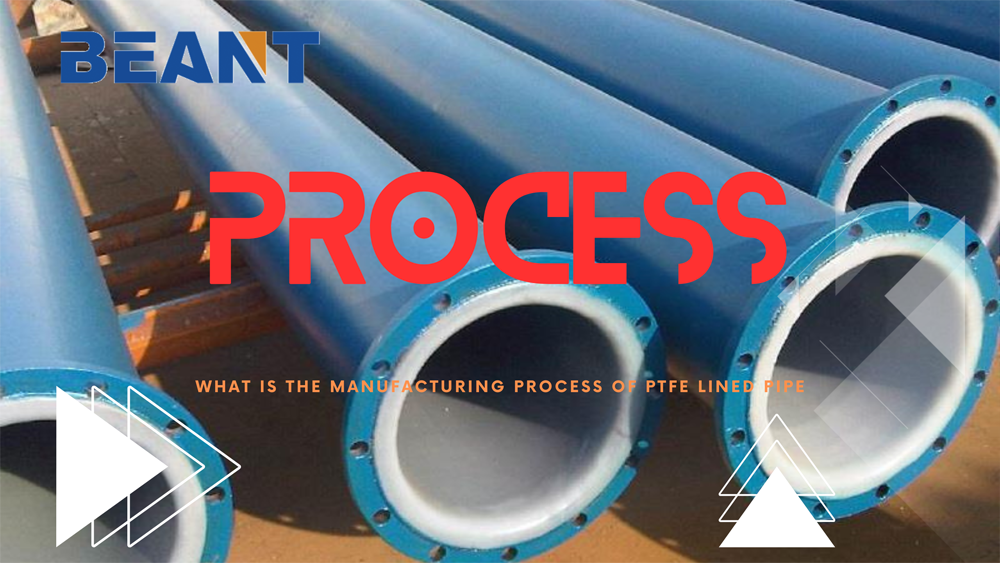
Polytetrafluoroethylene (PTFE) is a synthetic fluoropolymer of tetrafluoroethylene that has numerous applications due to its unique properties. It is best known for its low friction, high chemical resistance, and high melting point, making it an ideal material in a range of demanding applications. Chemically inert, PTFE does not react with most other chemicals, which allows it to perform well in environments that are acidic or basic. It also has an excellent thermal resistance with a melting point of approximately 327°C (620°F).
The robust properties of PTFE make PTFE lined pipes indispensable in industries where highly corrosive substances are processed. These industries include chemical processing, where aggressive acids, bases, and solvents are used; pharmaceuticals, where purity and contamination resistance are crucial; and food processing, which requires non-toxic, non-reactive, and easy-to-clean surfaces.
PTFE lined pipes consist of a metal pipe, typically steel or stainless steel, lined with a seamless PTFE liner. This configuration combines the strength and rigidity of metal pipes with the corrosion resistance and nearly universal chemical compatibility of PTFE.
The primary advantage of PTFE lined pipes lies in their ability to resist chemical attack, providing a durable solution in harsh chemical environments. Additionally, the smooth surface of PTFE minimizes friction, which facilitates the flow of materials and reduces energy costs. These pipes are widely used in applications involving corrosive chemicals, high temperatures, and sanitary requirements.
The manufacturing of PTFE lined pipes begins with the selection of suitable raw materials:
The lining of the pipe is made from PTFE resin, which is formed into a tube through a process called paste extrusion. The properties of PTFE resin that make it ideal for lining include:
Chemical Inertia: Unaffected by almost all industrial chemicals and solvents.
High Temperature Resistance: Operates effectively at temperatures up to 260°C (500°F).
Low Friction Coefficient: Facilitates the flow of materials, reducing clogs and maintenance.
The outer shell of the pipe is typically made from metals that provide structural integrity. Common materials include:
Carbon Steel: Cost-effective and durable, suitable for many industrial applications.
Stainless Steel: Offers enhanced corrosion resistance and is essential for pharmaceutical and food processing applications.
Table 1: Comparison of Metal Casings
| Material | Benefits | Uses |
| Carbon Steel | Cost-effective, high strength | General industrial applications |
| Stainless Steel | High corrosion resistance, non-reactive | Pharmaceuticals, food processing |
Selection and Cutting:The process begins with selecting the appropriate metal pipe, typically carbon steel or stainless steel, based on the application. The pipes are then cut to the required lengths using high-precision cutting tools to ensure smooth edges, which are essential for a proper fit of the PTFE liner.
Cleaning and Preparation:After cutting, the inner surface of the metal pipes is meticulously cleaned to remove any impurities, oils, or residues. This step is crucial as a clean surface is critical for the successful adhesion of the PTFE liner. Various mechanical and chemical cleaning processes may be employed, including grit blasting and acid washing, to prepare the surface.
Expansion of PTFE Resin:The PTFE liner is made through a process called paste extrusion. PTFE resin mixed with a lubricant is compressed under high pressure to form a paste, which is then extruded through a die to form a tube that matches the inner diameter of the metal pipe.
Sintering of Extruded PTFE:After extrusion, the PTFE tube is heated in a sintering oven to remove the lubricant and to cause the PTFE particles to fuse together, stabilizing the structure of the liner. This sintering process is critical as it enhances the mechanical properties and chemical resistance of the PTFE.
Techniques for Liner Insertion:The prepared PTFE liner is inserted into the metal pipe using various techniques. One common method is cold pushing, where the liner is manually pushed into the pipe at room temperature. Another method involves using hydraulic equipment to pull the liner into the pipe, ensuring a smooth and even fit.
Methods to Fix the Liner:To prevent the liner from shifting or collapsing during use, it is secured at both ends of the metal pipe. Techniques such as flaring or locking the liner with specially designed grooves at the ends of the pipe are used. These methods ensure that the liner remains firmly in place even under varying pressure and temperature conditions.
Ensuring a Secure Fit:Additional steps may be taken to ensure the liner does not collapse, such as applying external pressure or temperature during the securing process to enhance the bond between the liner and the metal pipe.
Inspection Processes:Every PTFE lined pipe undergoes rigorous inspection to ensure the integrity of the lining. Visual inspections, dimensional checks, and non-destructive testing methods are employed to detect any defects or inconsistencies.
Tests for Performance:The pipes are also tested for chemical resistance, thermal stability, and mechanical strength. These tests might include pressure tests, thermal cycling, and chemical exposure trials to validate the performance of the lining under operational conditions.
Final Surface Treatments:After passing all inspections and tests, the pipes undergo final surface treatments, which may include cleaning and polishing to prepare them for shipping and installation.
Marking for Identification:Each pipe is marked for traceability, which includes information such as batch number, date of manufacture, and material specifications. This information is crucial for maintaining quality control and for future reference during maintenance or replacement.
One of the primary challenges in manufacturing PTFE lined pipes is maintaining the integrity and adherence of the PTFE liner to the metal casing. Due to PTFE's non-stick properties, achieving a secure and durable bond between the liner and the metal pipe can be difficult. This can lead to issues such as liner detachment or wrinkling, which compromises the pipe's performance.
Advancements in manufacturing technology have led to innovative solutions to these challenges:
Improved Adhesion Techniques: New methods, such as chemical etching and plasma treatment, have been developed to increase the bond strength between PTFE and metal surfaces.
Automated Precision Machinery: Use of robotic and CNC machinery ensures precise alignment and insertion of the liner, minimizing human error.
PTFE lined pipes are crucial in applications that demand high chemical resistance and thermal stability. Their ability to handle aggressive chemicals without degrading makes them indispensable in industries like chemical processing, pharmaceuticals, and food production.
The quality of PTFE lined pipes heavily relies on meticulous manufacturing processes. Each step, from material selection to final inspection, must be carefully managed to ensure the pipes meet the highest standards of quality and performance.
Feel free to leave your message on our board. If you're looking to inquire about prices or place an order, this is the right place! Let us know the details of your needs, and our team will get back to you with a personalized quote as quickly as possible. We're here to ensure your experience is seamless and satisfactory. Share your requirements or ask any questions you might have - we're eager to assist and look forward to doing business with you!
Name:Tim
Phone:+86-15716151880
Email:[email protected]
Company:BEANT
Address:No. 28, Luoshen Road, Luoshe Town, Huishan District, Wuxi City, Jiangsu Province
